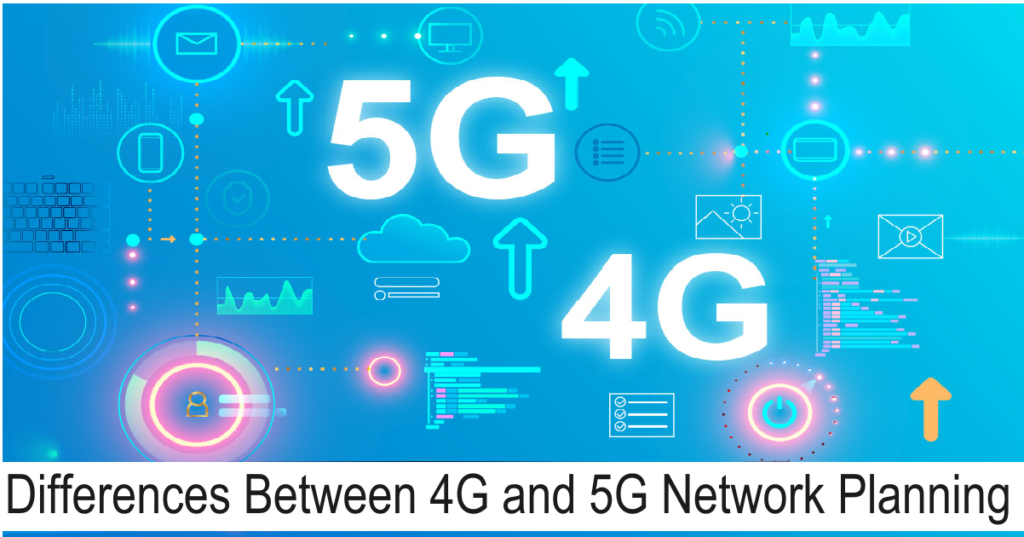5G mobile communication systems introduce significant advancements over 4G, utilizing new spectrum, air interface technologies, and network architectures to meet the diverse requirements of modern applications and the Internet of Everything (IoE).

These advancements cater to the evolving needs from human-to-human communication to a broader scope including human-to-machine and machine-to-machine interactions, shifting from voice-centric services to data-intensive and complex IoT services, and enhancing user experience from basic functionality to ultra-reliable, low-latency performance. These transitions present substantial challenges for radio network planning.
1. Spectrum Utilization.
4G Networks: Primarily operate within established frequency bands below 3 GHz, which are limited in availability and prone to congestion as data demands grow.
5G Networks: Employ a broader range of frequencies, including both sub-6 GHz bands and millimeter wave (mmWave) bands (above 24 GHz). This new spectrum provides higher capacity and faster data rates, but also requires different planning approaches due to the varying propagation characteristics of these frequencies.
2. Air Interface Technologies.
4G Networks: Utilize LTE (Long Term Evolution) air interface, which supports technologies like OFDMA (Orthogonal Frequency Division Multiple Access) for downlink and SC-FDMA (Single Carrier-Frequency Division Multiple Access) for uplink, with MIMO (Multiple Input Multiple Output) configurations to improve capacity and coverage.
5G Networks: Introduce the New Radio (NR) air interface, which supports advanced features like massive MIMO, beamforming, and flexible numerology to enhance spectral efficiency and capacity. 5G NR also includes mechanisms to support ultra-reliable low-latency communication (URLLC) and massive machine-type communication (mMTC).
3. Network Architecture.
4G Networks: Typically have a centralized architecture with a clear separation between the radio access network (RAN) and the core network. The evolution of 4G has seen the introduction of concepts like Cloud RAN (C-RAN) to centralize baseband processing and enhance efficiency.
5G Networks: Feature a more distributed and flexible architecture, incorporating edge computing and network slicing to cater to specific use cases and performance requirements. The core network in 5G is also more virtualized and software-driven, allowing for dynamic allocation of network resources.
4. Connectivity and Services.
4G Networks: Initially focused on improving mobile broadband and providing a more efficient and higher-capacity service for voice and data. Enhanced with VoLTE (Voice over LTE) and the ability to handle higher data traffic.
5G Networks: Designed to support a wide range of use cases beyond mobile broadband, including IoT applications, autonomous vehicles, smart cities, and industrial automation. The emphasis is on providing connectivity for a massive number of devices with diverse requirements in terms of bandwidth, latency, and reliability.
5. Network Planning Challenges.
4G Network Planning: Focuses on optimizing coverage and capacity within the available spectrum, often dealing with issues related to spectrum efficiency and interference management. The primary goal is to enhance data throughput and ensure reliable voice communication.
5G Network Planning: Involves addressing the complexities introduced by the new spectrum bands, particularly mmWave frequencies, which have different propagation characteristics and require denser cell deployment. The planning must also account for the diverse service requirements, ensuring that network slicing and edge computing are effectively implemented to meet the specific needs of different applications.
6. Radio Network Planning.
4G Network Planning: Typically involves traditional methods of site selection, coverage prediction, and capacity estimation based on historical traffic patterns and user density.
5G Network Planning: Requires a more sophisticated approach, incorporating advanced simulation tools and techniques to model the impact of higher frequency bands, beamforming, and massive MIMO. Planners need to consider the integration of small cells, distributed antenna systems (DAS), and other technologies to achieve the desired coverage and capacity, especially in dense urban environments.
Conclusion
The transition from 4G to 5G networks brings about significant differences in spectrum utilization, air interface technologies, network architecture, connectivity and services, and the challenges of network planning.
5G network planning must address the unique characteristics of new frequency bands, advanced technological features, and the diverse and demanding requirements of modern applications. This involves a more complex and dynamic approach compared to 4G, ensuring that 5G networks can deliver on their promise of enhanced performance, capacity, and reliability for a wide range of use cases.